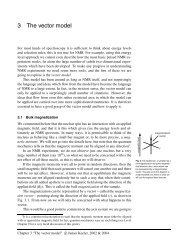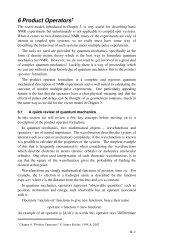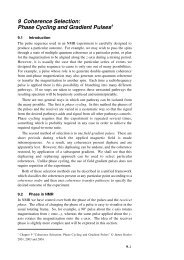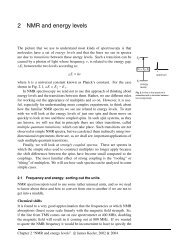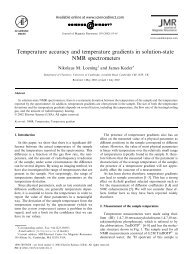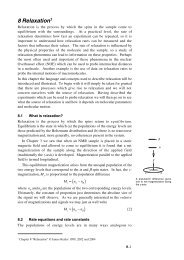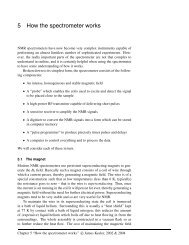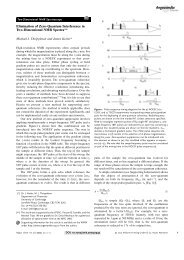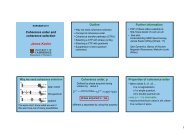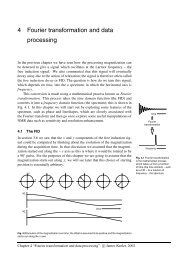Phase Cycling and Gradient Pulses - The James Keeler Group
Phase Cycling and Gradient Pulses - The James Keeler Group
Phase Cycling and Gradient Pulses - The James Keeler Group
You also want an ePaper? Increase the reach of your titles
YUMPU automatically turns print PDFs into web optimized ePapers that Google loves.
t 1 = 0<br />
t 1 = ∆<br />
t 1 = 2∆<br />
t 1 = 3∆<br />
x<br />
t 1 = 4∆<br />
–y<br />
–x<br />
y<br />
x<br />
t 2<br />
t 2<br />
t 2<br />
t 2<br />
t 1<br />
t 2<br />
Illustration of the TPPI method.<br />
Each time that t 1 is<br />
incremented, so is the phase of<br />
the pulse preceding t 1 .<br />
sampled at regular intervals ∆. After transformation the resulting spectrum<br />
displays correctly peaks with offsets in the range –(SW/2) to +(SW/2) where SW<br />
is the spectral width which is given by 1/∆ (this comes about from the Nyquist<br />
theorem of data sampling). Frequencies outside this range are not represented<br />
correctly.<br />
Suppose that the required frequency range in the F 1<br />
dimension is from<br />
–(SW 1<br />
/2) to +(SW 1<br />
/2). To make it appear that all the peaks have a positive<br />
offset, it will be necessary to add (SW 1<br />
/2) to all the frequencies. <strong>The</strong>n the peaks<br />
will be in the range 0 to (SW 1<br />
).<br />
As the maximum frequency is now (SW 1<br />
) rather than (SW 1<br />
/2) the sampling<br />
interval, ∆ 1<br />
, will have to be halved i.e. ∆ 1<br />
= 1/(2SW 1<br />
) in order that the range of<br />
frequencies present are represented properly.<br />
<strong>The</strong> phase increment is ω add<br />
t 1<br />
, but t 1<br />
can be written as n∆ 1<br />
for the nth<br />
increment of t 1<br />
. <strong>The</strong> required value for ω add<br />
is 2π(SW 1<br />
/2) , where the 2π is to<br />
convert from frequency (the units of SW 1<br />
) to rad s –1 , the units of ω add<br />
. Putting<br />
all of this together ω add<br />
t 1<br />
can be expressed, for the nth increment as<br />
ω t SW1<br />
additional 1<br />
= 2π<br />
⎛ ⎞ n<br />
1<br />
⎝ 2 ⎠ ( ∆ )<br />
SW1<br />
1<br />
= 2π<br />
⎛ ⎞⎛<br />
⎞ n<br />
⎝ 2 ⎠⎜<br />
⎟<br />
⎝ 2 SW<br />
1 ⎠<br />
π<br />
= n<br />
2<br />
In words this means that each time t 1<br />
is incremented, the phase of the signal<br />
should also be incremented by 90°, for example by incrementing the phase of<br />
one of the pulses.<br />
A data set from an experiment to which TPPI has been applied is simply<br />
amplitude modulated in t 1<br />
<strong>and</strong> so can be processed according to the method<br />
described above for cosine modulated data so as to obtain absorption mode<br />
lineshapes. As the spectrum is symmetrical about F 1<br />
= 0, it is usual to use a<br />
modified Fourier transform routine which saves effort <strong>and</strong> space by only<br />
calculating the positive frequency part of the spectrum.<br />
9.4.4.4 States-TPPI<br />
When the SHR method is used, axial peaks (arising from magnetization which<br />
has not evolved during t 1<br />
) appear at F 1<br />
= 0; such peaks can be a nuisance as<br />
they may obscure other wanted peaks. We will see below (section 9.5.6) that<br />
axial peaks can be suppressed with the aid of phase cycling, all be it at the cost<br />
of doubling the length of the phase cycle.<br />
<strong>The</strong> States-TPPI method does not suppress these axial peaks, but moves<br />
them to the edge of the spectrum so that they are less likely to obscure wanted<br />
peaks. All that is involved is that, each time t 1<br />
is incremented, both the phase of<br />
the pulse which precedes t 1<br />
<strong>and</strong> the receiver phase are advanced by 180° i.e. the<br />
9–20



